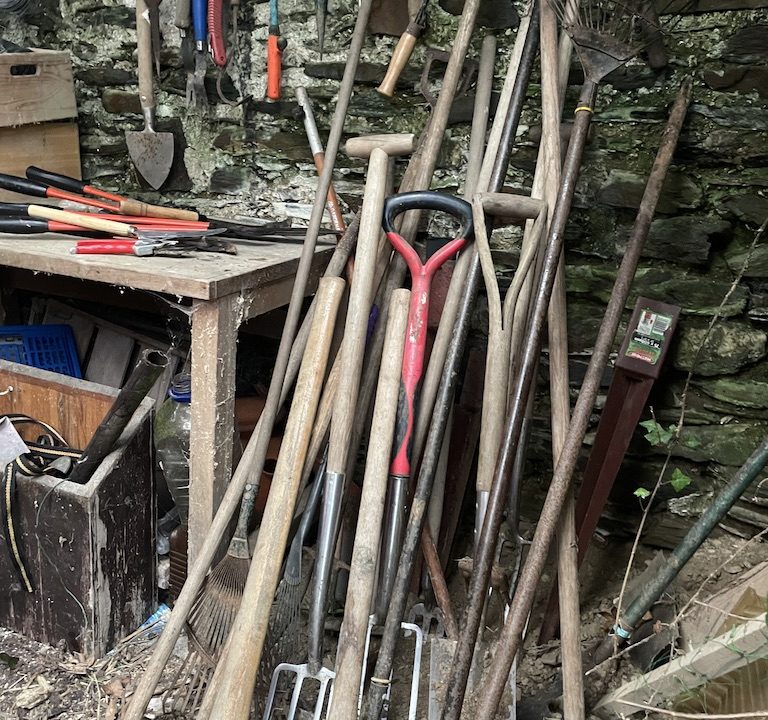What tools does a gardener really need?
The days are getting longer and with the snow drops appearing there is just the whiff of Spring. So, it’s time to clear out and get back to basics. Our resident gardening expert, Alison Agnew, roots about in her shed and considers what gardening tools we really do need.
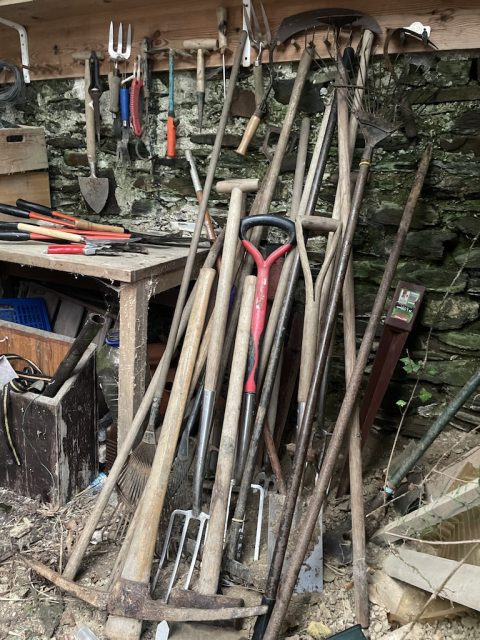
My shed is a mess, far too many tools and stuff.
My daughter and her family are moving out of London to the countryside and she is excitedly planning the first ‘proper’ garden of her life. In London she made a beautiful small border just over 1m wide and 7m long alongside a tiny lawn for her young sons to muck about on. The upscaling to 2 acres will come as a shock, I fear, with her plans being probably way overambitious in the context of a demanding career and family. Wanting to give her a suitable Christmas present for this great new adventure led me to consider what were the really essential tools for a new gardener.
Using her proposed new garden as a model, I’ll look at the minimum tools I think she needs. She wants a small veggie patch with a greenhouse or small poly tunnel, a small flower/rose garden, a kick-about lawn for the kids and the rest will be ‘re-wilded’ meadow, orchard and trees.
- Secateurs: at least one pair but probably two because you always leave one somewhere where it’ll turn up later. Always buy the best quality tool that you can afford – in this case Felco – because they sell all the parts to refurbish them. So even if you lose them in the compost heap for a year you can replace the rusted spring and blades!
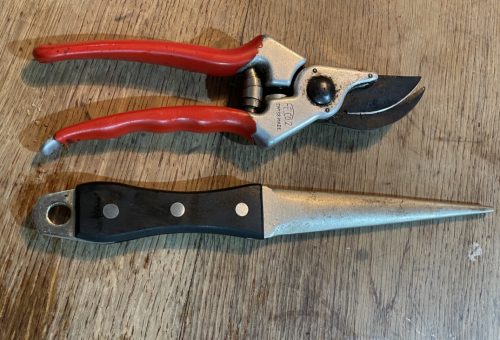
- Hand trowel – I like a narrow pointed one in stainless steel. It’ll do for most jobs including bulb planting and will last forever if you don’t rot off the handle by losing it in the compost. Don’t bother with a hand fork unless it comes as a set – not essential.

- Hori hori knife – this is the first of the Japanese tools I now regard as essential. It is part knife, part root saw and part trowel – in fact you could probably even do without a trowel if you have one of these. They are usually made of stainless steel with a wooden handle and there are more or less posh versions on the market with different handles and sheaths. They are pretty vicious objects and best bought with a sheath that you can attach to a belt. Just remember to take it off when you go out shopping or you could get arrested for carrying!
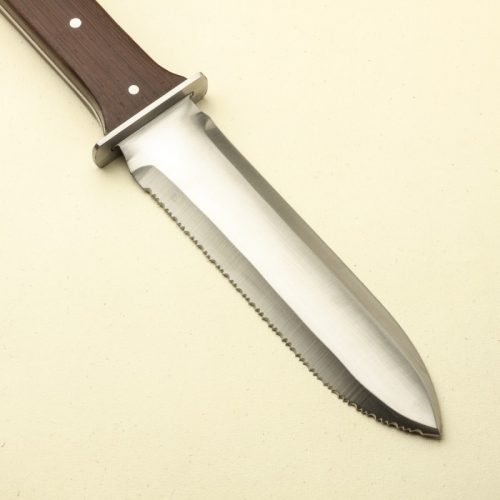
- The second Japanese hand tool that I can’t live without is a single edge weeding hoe. It has a short handle with a stem about 30cm long and a flat tapering blade at just the right angle for slicing through the roots of weeds just below the soil surface. Made of carbon steel, it must be kept razor sharp with a stone or diamond sharpener and stored dry to prevent rust. It is worth taking care of – just the best tool EVER for weeding in tight spaces, between plants and even hooking weeds out from within a clump.
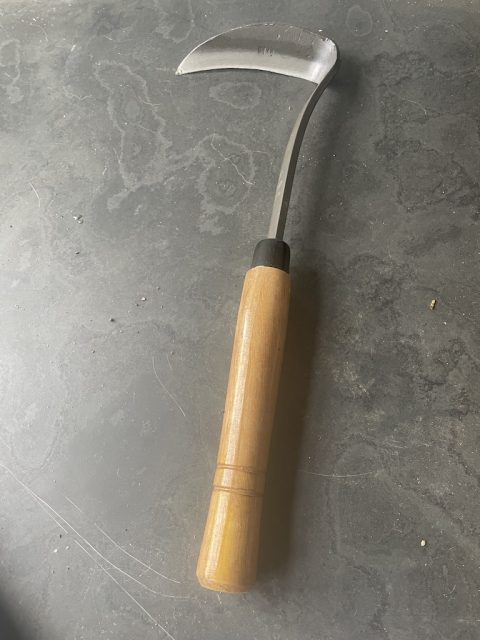
- The third Japanese hand tool that I have only just acquired but is proving its worth is a gardener’s sickle. This has a 20cm wooden handle and a 16cm curved, finely serrated blade. It is fantastic for cutting down dead and dying perennials. For example, it chomps through great clumps of stringy Iris siberica leaves with one stroke. It is, however, another great tool that you should not leave around with small children.
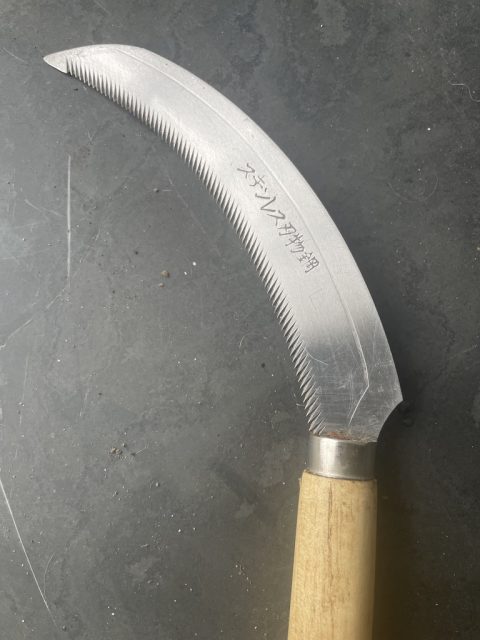
- Shears – the need for shears is dependant on the type of garden you have. A good pair, kept sharp, is useful but I think most people would be better off with a light-weight battery-operated hedge trimmer. This can be used for pruning many shrubs, including Hydrangeas, Pittisporums etc as well as hedges. The RHS have even done a trial showing that a hedge trimmer is as good as secateurs for pruning shrub roses – and a lot quicker! We have started using one to cut down perennials as well. It has the advantage that you can slice the tall dead stems down in stages which makes them both easier to rake out and to compost.
- The next scale up is digging tools. Once an area of garden is established, I don’t dig much at all and my veggie garden is no-dig apart from lifting root crops. I almost never use a spade so I would say that the absolute minimum digging tools needed are a light, stainless steel border fork and a stronger one for heaving out the many stones that our Roseland soils seem to breed.
- Rakes – you need a soil rake for landscaping, levelling soil and raking gravel paths if you have them. I think most people can do without a large wire rake but I find a small hand wire rake very useful for pulling dead material and leaves out from around perennials.
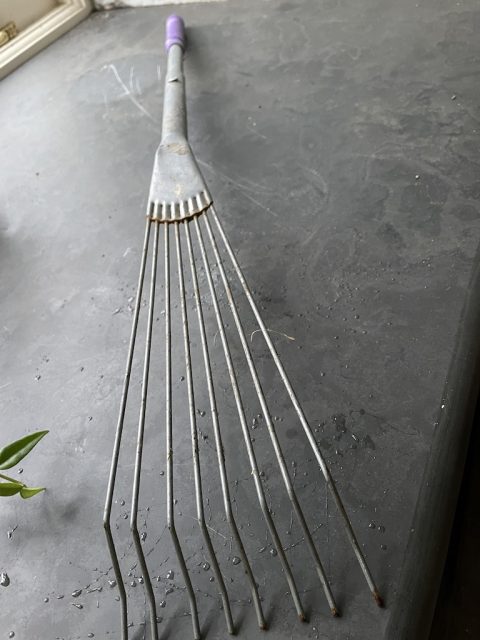
At this point you probably have all you really need for the vegetable and flower garden. What about lawns, trees and meadows?
- Lawnmowers are not my thing – I avoid mowing lawns by getting someone else to do it. From an ecological and labour-saving point of view I would advocate mulching mowers which chew up the grass and put it back on the lawn. Buy the best you can afford and have it serviced once a year.
- Alternatively, with only one or two short grass areas and no partner to mow for me, I would be tempted by a robot mower. The good ones are expensive but if you take into account paying someone to mow or saving your very valuable time to sit and enjoy your garden, maybe they’re worth it.
- As for mowing a meadow – forget it, get a friendly farmer in once or twice a year or a gardening service with the right flail mower. It’s not worth owning an expensive bit of kit to use it once a year.
And what about the trees/orchard? The only maintenance you can do is to remove small branches/ dead wood and gentle pruning so all you really need is:
- A small sharp pruning saw – the foldable sort are good.
- A pair of long handled loppers – the extendable ones are useful.
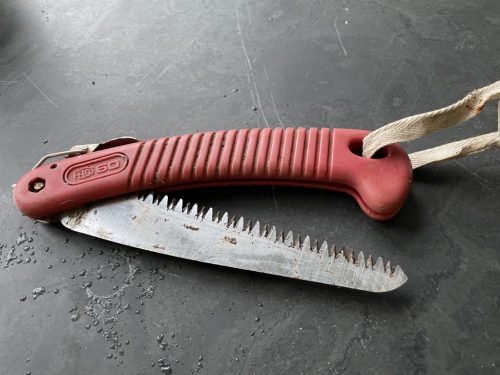
All other tree work should be done by a tree surgeon – they know what they are doing and don’t usually drop branches on their heads or bring down power lines.
Last but far from least:
- Some means of sharpening your tools easily so that you actually do it frequently. I have a grinding wheel in the garage and several hand held sharpeners but if I had to go down to a single one it would be a diamond coated file – one that tapers to a point with one curved and one flat side.
Oh – and a sledge hammer and (in our soil) a crow bar and a three pronged cultivator and…. oh dear, I’ll never clear out my shed.

